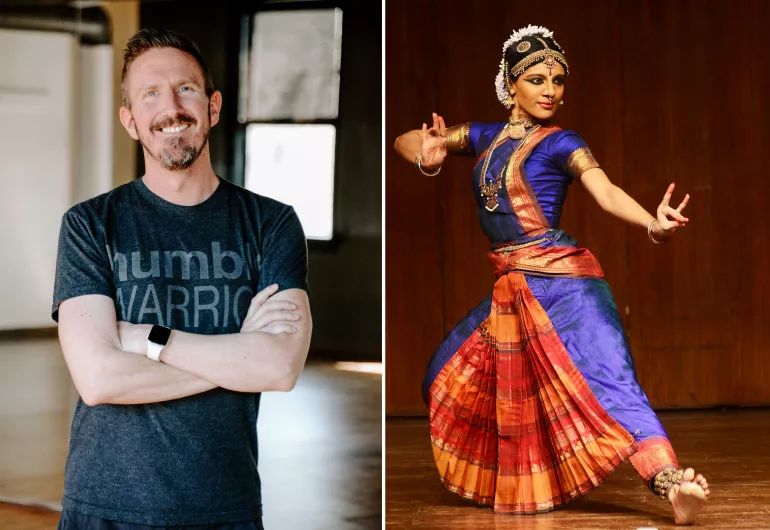Northrop Presents
Bharatanatyam and Yoga: A Shared Connection
Past event
Apr 19, 2021
Captioning

As an art form, Bharatanatyam demands the conscious understanding of body, mind and spirit; this often translates as the balance of multiple qualities within each movement: strength and flexibility, inner relaxation and focus. Ultimately, both Bharatanatyam and yoga ask the practitioner to find their inner divinity in order to transcend the distractions and obstacles of the physical world.
This free, in-person and online workshop begins with an introduction by Ragamala’s Artistic Directors Ranee and Aparna Ramaswamy, followed by an all-levels yoga practice led by Aaron Asmundson, Program Director for Leadership Enrichment Programs at the University of Minnesota. Bring your own yoga mat and wear comfortable clothes--or join from the comfort of your home.
According to Indian myth, dance was created by the gods for the enjoyment of people, an art that is both audible and visible, accessible to all. From the existing four scriptures, Brahma—the Hindu god of creation—took music, storytelling, rhythm, and gestures and created a fifth scripture, the scripture of dance. He gave it to the Hindu god Shiva, who became the first dancer.
As Nataraja, the Lord of Dance, Shiva performs both Lasya—a soft dance representing the creation of the world—and Tandava—an energetic dance representing the destruction of the world. Lasya and Tandava can also be understood as the feminine and masculine energies.
Because Indian dance was taught as an oral tradition, over centuries it traveled and absorbed the cultural diversity of India, resulting in five current styles of classical dance, each from a different part of India. Bharatanatyam—the dance form performed by Ragamala Dance Company—is from the southeast part of India.
Shiva is also known as a supreme guru of yoga. He is said to have transmitted seven aspects of yoga into seven sages known as the Saptarishis, who distributed this knowledge to different parts of the world. Yoga is said to have maintained these seven forms today.
Yoga and Bharatanatyam are two systems of spiritually-based movement that can offer different ways of experiencing embodiment. There are many similarities in both the tradition and practice of yoga and Bharatanatyam.
Yoga and Bharatanatyam are both traditionally taught within the guru-shishya tradition (a lifelong mentorship between teacher and disciple). The formal study of yoga and dance both require commitment and dedication for a lifetime. Yoga and dance are both longstanding traditions with multiple historical influences that have contributed to the development of each form over time.
There are similarities in the physical forms of yoga and Bharatanatyam. In both traditions, the movements or postures are based on the center line of the body in relation to gravity, both traditions keep the head, neck, and spine straight and balanced. They are both grounding and stabilizing, and cultivate a deep presence and stillness in concentration.
Hasta Mudra is translated from Sanskrit as “gesture.” Mudras are used for external communication in dance, and they are used for internal communication in yoga.
In yoga, Mudra practice establishes a connection between the physical, mental, and energy bodies, and can lead to energy being directed within the body. They can be used in conjunction with physical postures, breathwork, chanting, and meditation.
In Bharatanatyam, there are 28 single-handed gestures (Asamyukta Hasta), and 24 double-handed gestures (Samyukta Hasta) identified in the Natya Shastra, the text of dance.
Hastas are part of an artistic language of poetry, gesture, and dance through which one can convey self-expression. These gestures, along with a dancer’s facial expression, emotions, and body posture, help to communicate stories with the audience. This expressive dance is called Abhinaya.
In addition to the expressive dance, Hastas can be used to as aesthetic movement in rhythmic dance. Bharatanatyam dancers use various part of their feet to beat out complex rhythms on the floor. There are over 30 rhythmic steps—Adavus—that combine feet, hands, and the entire body. This rhythmic dance is called Nritta.
In our dance, once these basic techniques became second nature, one can internalize this emotional energy in the body and radiate out beauty, strength, and grace, creating a shared experience with an audience. This is called Rasa.
In yoga, a similar emotional energy moves inward through introspection. The alignment and form in asana practice is intended to cultivate awareness, relaxation, concentration and meditation. Asana practice can strengthen the body, teach us to live in harmony with nature, activate energetic centers that help evolve human consciousness, and release obstacles to integrating mind and body.
Both disciplines integrate inner, subjective experience with outer, objective form, and in doing so, they operate on the physical, psychic, and spiritual levels simultaneously.